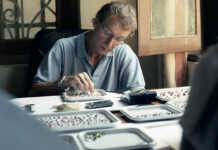
RING LEADER
The stunning handwork of Vladimir Chakharian and Almari Design.
by Sarah B. Hood
“I am like a rhinoceros in Canada; nobody does this work anymore,” declares Vancouver-based Vladimir Chakharian of Almari Design.
Chakharian is a specialist in the painstaking traditional craft of engraving. He began his training as a youth in Russia under his father, Vartan Chakharian. He also studied foreign languages, becoming skilled in French, and applied to the Government of Quebec to move there.
“I came to Montreal, because I didn’t know that Toronto or Vancouver existed. For me, Canada was Montreal,” he says. He arrived in 1993, imagining that he would pursue a teaching career. However, he soon found he would be required to study for an additional three years before he could be certified to teach in the regular school system.
With a family to support, Chakharian felt he couldn’t afford the investment in time. However, he was happy to turn his sights on jewellery again, because, he says, “jewellery was my big pleasure: you start and you finish, [whereas] when you teach, you never see the result.”
In a very short time, Chakharian opened his own office in downtown Montreal. His skills were soon in demand for high-quality gifts and ceremonial pieces, including both jewellery and items like medals, cigar cutters and flasks. “I was making hand engraving for jewellery stores and for manufacturers, and I was doing my jewellery for private people,” he says. He also exercised his teaching skills as an instructor at the Cégep du Vieux Montréal, which has a high reputation for its fine arts programs.
In 1997, he built his first website. “I started little by little to show my work; the first website was very simple,” he says.
Since then, it has grown a lot; in fact, the site now drives much of his business, he says: “Ninety per cent of my customers are Americans. I made a couple of rings for Australia, New Zealand, Norway, only two or three in England; I receive lots of requests from Turkey.”
His son Albert Chakharian, who owns his own internet business, assisted with the initial design and has helped ensure that the site performs well with search engines. These days, Chakharian focuses strongly on signet rings, and the site is optimized so that a potential customer who uses Google’s image search function to browse for signet rings will almost certainly spot some of Chakharian’s work and be drawn to his site.
In September of 2004, the lease on his Cathcart Street office ran out, and a stone setter friend somewhat casually suggested Chakharian should explore the city of Vancouver. He took a trip out west, liked what he saw and packed his tools. “One month later, I was already in Vancouver,” he says. “My wife came from Montreal with my daughter and my son came from Toronto.”
Chakharian still takes pleasure in his craftsmanship. “I never copy something from somebody; I hate to repeat the same piece two time or three times,” he says. Occasionally he puts the time into a unique piece like a gold watch for someone in his own family.
He collects books about the history of design, which he consults for inspiration. At one time he used to drive to New York frequently to visit a particular 28th Street shop. “I was driving seven hours at least three times a year,” he says. “I was sitting there hours and hours choosing the books.”
Of all the historical design styles, he says, “my favourite is Victorian style; I find Victorian design is the richest one. You look at the Victorian arabesque; the arabesque in the Empire style is completely different.”
Unfortunately, “[The] North American market is not built for engravers. The problem is the generation of hot dogs and hamburgers; they are very far from hand engraving and the Victorian style, the iPod and iPhone generation.” He believes the jewellery industry has a role to play in keeping hand engraving alive, since “if you do not show high-end jewellery, nobody will buy it.
“But some families, they keep the history, and the people remember their background and they know the culture; they know the country they came from,” he says. “I know that this work will be appreciated after my death, like a Modigliani.” CJ

















